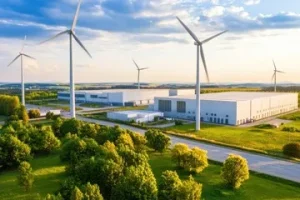Economic Impacts of Green Hydrogen Projects: Jobs, Investments, and Growth
Let’s start with understanding what green hydrogen projects really involve. These are large-scale initiatives that produce hydrogen through electrolysis powered by renewable sources like solar and wind. Far from being just clean energy experiments, they’re becoming powerful economic engines. Each project spans infrastructure development, electrolyser deployment, storage systems, transport networks, and integration into industrial processes.
As the world accelerates its shift toward renewable energy, green hydrogen is emerging not just as an environmental game-changer, but as an economic powerhouse. Across global markets, this clean fuel is driving a new industrial revolution—fuelling massive investments, job creation, and GDP growth.
Governments, private investors, and energy innovators are betting big on large-scale hydrogen projects to cut emissions, decarbonise industries, and future-proof energy supply chains. But beyond the headlines on climate goals, the real story lies in what green hydrogen means for jobs, capital flows, and regional development.

1. Massive Job Creation Across the Value Chain
From engineering and infrastructure to logistics and tech innovation, green hydrogen projects are opening up an entirely new employment ecosystem. The International Renewable Energy Agency (IRENA) estimates that hydrogen could support over 30 million jobs globally by 2050, with many of those stemming directly from green hydrogen hubs, construction of storage facilities, and operation of electrolyser plants.
In regions hosting green hydrogen hubs, local talent pools are being upskilled to meet demand in areas such as renewable power integration, water electrolysis, safety protocols, and maintenance of large-scale facilities.
2. A Magnet for Global Investments
Countries are racing to attract private capital with subsidies, tax incentives, and policy frameworks that favour green hydrogen production. The result? A sharp uptick in funding. Billions are now being funneled into:
- Production capacity scale-ups
- Development of project databases for tracking progress and partnerships
- Infrastructure for transport, export, and ammonia production
For instance, Europe’s Hydrogen Backbone project and India’s National Green Hydrogen Mission are drawing investments not just from energy giants but also from tech companies, sovereign funds, and venture capital firms betting on long-term growth.
3. Industrial Revitalisation Through Green Hydrogen
Heavy industries such as steel, fertilisers, chemicals, and cement are all being revolutionised. One of the most prominent shifts is in green ammonia and ammonia production, where green hydrogen acts as a clean feedstock—replacing traditional methods reliant on fossil fuels.
This transformation is breathing new life into industrial zones by modernising existing infrastructure, attracting ancillary industries, and boosting regional manufacturing capabilities. These green upgrades also enable existing companies to remain globally competitive as ESG standards tighten.
4. Economic Resilience & Export Opportunities
Hydrogen-rich countries like Australia, Chile, UAE, and India are well-positioned to become export powerhouses by leveraging their solar and wind energy resources to produce millions of tonnes of green hydrogen annually.
These exports can take the form of compressed hydrogen, green ammonia, or liquid organic hydrogen carriers, helping diversify national income streams and reduce dependence on traditional fossil fuel exports. The development of hydrogen storage facilities and export terminals adds further resilience and revenue to local economies.
5. Boosting Innovation and Startup Ecosystems
The rise of green hydrogen is fuelling a wave of innovation, from start-ups developing advanced electrolyser technology to companies offering AI-based project database platforms and hydrogen-safe storage solutions. As a result, new ecosystems are forming around hydrogen tech—boosting GDP through entrepreneurship, IP creation, and tech exports.
Governments are also funding R&D and pilot projects, catalysing breakthroughs that not only enhance production capacity but also lower costs—making green hydrogen more accessible and scalable.
Final Thought
The green hydrogen boom is no longer just a climate story—it’s an economic evolution in motion. From job creation to global investments and export-led growth, the ripple effects of hydrogen innovation are reshaping the energy economy.
And as green hydrogen projects scale to meet the demand for millions of tonnes of clean fuel, they’re laying the foundation for a more inclusive, sustainable, and prosperous future.
Power the Future with YonderH2
At YonderH2, we’re not just observing the green hydrogen revolution—we’re building it. With advanced solutions across production, storage, and green ammonia infrastructure, we help turn bold energy visions into reality.
Looking to invest, partner, or scale your hydrogen goals?
Let’s make it happen. Connect with YonderH2 today.
The global shift towards green hydrogen is more than just an environmental initiative—it’s a powerful economic opportunity. As countries and industries invest in green hydrogen projects, they are not only taking steps to decarbonize but are also opening the door to a new era of job creation, investments, and economic growth. By harnessing renewable energy to produce hydrogen, these projects are poised to create lasting impacts on local economies and global markets. Let’s explore how green hydrogen is shaping the economy and why it’s considered a game-changer for the future.

- Job Creation Across Multiple Sectors
One of the most significant economic benefits of green hydrogen projects is the job creation potential. As the hydrogen industry scales up, it spurs employment opportunities in various sectors, including renewable energy, engineering, manufacturing, and transportation.
Key Job Drivers:
- Renewable Energy Infrastructure: Projects require the installation of solar panels, wind turbines, and electrolysis plants—all of which demand skilled labor, from construction workers to engineers.
- Hydrogen Production and Distribution: Establishing and maintaining electrolysers, storage facilities, and transportation networks for hydrogen will require a wide range of workers, from plant operators to logistics managers.
- Research and Development: With the growing demand for efficient hydrogen production methods and fuel cell technology, there’s a significant need for scientists, engineers, and technicians to drive innovation.
- This job creation goes beyond just short-term gains. The green hydrogen sector is expected to provide sustainable employment for decades, creating career opportunities in both developed and emerging economies. According to the International Renewable Energy Agency (IRENA), the hydrogen sector could create up to 30 million jobs globally by 2050.
- Attracting Investments and Boosting Economic Growth
Green hydrogen projects are not only generating jobs; they are also attracting significant levels of investment. Both private investors and public sector funding are flowing into green hydrogen initiatives as governments and industries recognize the long-term potential.
Investment Opportunities:
- Infrastructure Development: The establishment of hydrogen production plants, storage solutions, and transportation networks requires substantial capital investment. This opens up opportunities for investors in the infrastructure, construction, and energy sectors.
- Tech Innovation: As demand for green hydrogen increases, private companies are rushing to develop new technologies to make the process more efficient and cost-effective. Innovations in electrolyser technologies, hydrogen storage solutions, and fuel cells are attracting investments in startups and R&D.
- Governments are also heavily investing in green hydrogen as part of their economic recovery strategies. Many nations are launching green hydrogen strategies that include subsidies, tax incentives, and grants to encourage private sector investment. For example, the European Union has committed billions of euros to developing a hydrogen economy across its member states, further driving both public and private investment in the sector.
The influx of investment not only accelerates the deployment of hydrogen projects but also acts as a catalyst for economic growth. With green hydrogen acting as an enabler for clean energy transition, economies are expected to see new growth opportunities, including the development of new markets and supply chains.
- Diversification of Energy Markets
Green hydrogen is transforming the way energy markets operate by enabling energy diversification. While many countries currently rely on fossil fuels for power generation, green hydrogen offers a pathway to energy independence and security.
Impact on Global Energy Markets:
- Renewable Energy Utilization: Green hydrogen allows countries with abundant renewable energy resources, like solar or wind, to turn excess power into a valuable commodity. Countries that previously imported fossil fuels can now produce their own clean hydrogen, diversifying their energy markets and boosting local economies.
- Cross-Border Trade: As green hydrogen production expands, so will international trade. Countries rich in renewable resources, such as Australia and Chile, are well-positioned to export hydrogen to regions with energy deficits, such as Europe and Asia. This international trade will create a new global market and increase economic cooperation between nations.
By integrating green hydrogen into the energy market, countries can reduce dependence on volatile fossil fuel markets, offering a more stable and sustainable energy future.
- Revitalizing Rural and Underserved Areas
Green hydrogen projects are not just concentrated in major urban centers; they have the potential to revitalize rural and underserved areas. Many green hydrogen initiatives, such as renewable energy generation and hydrogen production plants, are being developed in remote regions with abundant renewable resources.
Economic Revitalization for Rural Communities:
- Infrastructure Investment: Rural areas can benefit from new infrastructure investments related to solar farms, wind turbines, and hydrogen production plants, providing an economic boost and improving local access to clean energy.
- Local Job Creation: As hydrogen plants and renewable energy projects come online, they create a demand for skilled labor and local contractors, thus generating new employment opportunities in areas where jobs are often scarce.
This influx of investment helps build more resilient local economies, promotes energy access in underserved regions, and reduces inequalities by spreading the benefits of the green energy revolution to less-developed areas.
- Contributing to Sustainability and Long-Term Economic Resilience
Perhaps the most significant long-term benefit of green hydrogen projects is their contribution to building a sustainable economy. By reducing carbon emissions, green hydrogen helps mitigate the impacts of climate change, ensuring the long-term stability of economies globally.
Economic Resilience through Sustainability:
- Environmental Benefits: Green hydrogen projects help meet climate goals by reducing greenhouse gas emissions, which is crucial for protecting industries from the economic impacts of climate change. By transitioning to a clean energy system, industries become more resilient to disruptions caused by extreme weather events and resource scarcity.
- Sustainability as a Competitive Advantage: Businesses and countries that embrace green hydrogen are positioning themselves as leaders in the growing green economy, which can attract more investments, foster innovation, and enhance global competitiveness in the long run.
Conclusion
Green hydrogen is not just a technological innovation; it’s a transformational force for the global economy. From creating millions of new jobs to boosting investments in clean energy, green hydrogen projects are offering unparalleled economic opportunities. They are reshaping energy markets, revitalizing rural communities, and driving sustainability in industries across the world.
As countries and businesses continue to invest in green hydrogen, the economic impacts will only grow more significant, helping to fuel the transition to a low-carbon future while creating a more resilient, sustainable global economy. With the rise of green hydrogen companies in India, the nation is positioned to play a pivotal role in this transformation, driving both environmental and economic growth with innovative, sustainable solutions.





